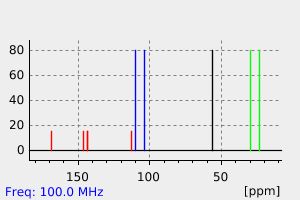7-羟基-6-甲氧基-3,4-二氢色烯-2-酮 | 90843-91-7
中文名称
7-羟基-6-甲氧基-3,4-二氢色烯-2-酮
中文别名
——
英文名称
scopoletin
英文别名
7-hydroxy-6-methoxy chroman-2-one;7-Hydroxy-6-methoxy-3,4-dihydro-2H-1-benzopyran-2-one;7-hydroxy-6-methoxy-3,4-dihydrochromen-2-one
CAS
90843-91-7
化学式
C10H10O4
mdl
——
分子量
194.187
InChiKey
XEHFSYYAGCUKEN-UHFFFAOYSA-N
BEILSTEIN
——
EINECS
——
-
物化性质
-
计算性质
-
ADMET
-
安全信息
-
SDS
-
制备方法与用途
-
上下游信息
-
文献信息
-
表征谱图
-
同类化合物
-
相关功能分类
-
相关结构分类
物化性质
-
沸点:391.1±42.0 °C(Predicted)
-
密度:1.327±0.06 g/cm3(Predicted)
计算性质
-
辛醇/水分配系数(LogP):1.3
-
重原子数:14
-
可旋转键数:1
-
环数:2.0
-
sp3杂化的碳原子比例:0.3
-
拓扑面积:55.8
-
氢给体数:1
-
氢受体数:4
上下游信息
-
上游原料
中文名称 英文名称 CAS号 化学式 分子量 3-(2,4-二羟基-5-甲氧基-苯基)-丙酸 3-(2,4-dihydroxy-5-methoxy-phenyl)-propionic acid 824950-88-1 C10H12O5 212.202 -
下游产品
中文名称 英文名称 CAS号 化学式 分子量 —— 6-methoxychroman-2,7-diol 439573-62-3 C10H12O4 196.203 —— 6-methoxy-4H-1-benzopyran-7-ol —— C10H10O3 178.188
反应信息
-
作为反应物:描述:7-羟基-6-甲氧基-3,4-二氢色烯-2-酮 在 二异丁基氢化铝 作用下, 以 四氢呋喃 、 正己烷 为溶剂, 反应 0.5h, 以88%的产率得到6-methoxychroman-2,7-diol参考文献:名称:Synthesis of 6-methoxy-4H-1-benzopyran-7-ol, a character donating component of the fragrance of Wisteria sinensis摘要:6-Methoxy-4H-1-benzopyran-7-ol 7, a major impact flavor compound of Wisteria sinensis has been synthesized from 2,4,5-trimethoxybenzaldehyde 1 via scopoletin 3. The synthetic sequence comprised (i) bisdemethylation of 2,4,5-timethoxybenzaldehyde 1, (ii) Wittig reaction with ethoxycarbonylmethylenetriphenylphosphorane, (iii) hydrogenation on palladium/carbon in glacial acetic acid, (iv) DIBAL-H reduction of the intermediate lactone and (v) dehydration of the lactol with anhydrous oxalic acid. (C) 2002 Elsevier Science Ltd. All rights reserved.DOI:10.1016/s0040-4020(02)00081-9
-
作为产物:参考文献:名称:Synthesis of 6-methoxy-4H-1-benzopyran-7-ol, a character donating component of the fragrance of Wisteria sinensis摘要:6-Methoxy-4H-1-benzopyran-7-ol 7, a major impact flavor compound of Wisteria sinensis has been synthesized from 2,4,5-trimethoxybenzaldehyde 1 via scopoletin 3. The synthetic sequence comprised (i) bisdemethylation of 2,4,5-timethoxybenzaldehyde 1, (ii) Wittig reaction with ethoxycarbonylmethylenetriphenylphosphorane, (iii) hydrogenation on palladium/carbon in glacial acetic acid, (iv) DIBAL-H reduction of the intermediate lactone and (v) dehydration of the lactol with anhydrous oxalic acid. (C) 2002 Elsevier Science Ltd. All rights reserved.DOI:10.1016/s0040-4020(02)00081-9
文献信息
-
Structural features controlling cation-radical line-broadening in the 1H-NMR spectra of phenol derivatives in acid media作者:Isam K.L. Al-Khayat、Francis M. Dean、Rajender S. VarmaDOI:10.1016/s0040-4020(01)86907-6日期:1987.1of cation radicals from 2,3,4,7-8,9-hexahydro-2,2,5.7,7, 10-hexamethylbenzo[1,2-b; 4,5-b']dipyran (1) and the isomeric benzo[1,2-b; 4,3-b']dipyran (3) have been characterised. The production of cation radical from (1) in acid media is limited by acid concentration for weak acids and also by the presence of oxygen for strong acids. The cation radical species (Ar+) is considered to originate from substrate来自2,3,4,7-8,9-六氢-2,2,5.7,7,10-六甲基苯并[1,2-b]的阳离子的六氯锑酸酯; 4,5-b']双吡喃(1)和异构体苯并[1,2-b; 已经表征了4,3-b′]双吡喃(3)。在弱酸中,由(1)在酸性介质中产生的阳离子自由基受到酸浓度的限制,而对于强酸,氧的存在也受到限制。阳离子自由基种类(Ar +)被认为是通过质子化从底物(Ar)产生,然后从中性底物(Ar)进行电子转移; 仅当这种转移在结构上有利时,酚衍生物的H-nmr谱线才会展宽。立体化学作用极大地降低了对酸的敏感性,并且在苯-1,2,4-三醇的衍生物中,在一个环中存在两个氧原子是极其不利的。由于酚阳离子自由基是相当强的酸,因此最好通过醚(通过氧化剂或循环伏安法)研究它们在弱酸介质中的行为。
-
Moore, Journal of the Chemical Society, 1911, vol. 99, p. 1044作者:MooreDOI:——日期:——
-
Extracts of Curcuma and Methods of Use Thereof申请人:Alberte Randall S.公开号:US20100098788A1公开(公告)日:2010-04-22The present invention relates in part to turmeric extracts that are useful for treating or preventing neurodegenerative disorders. Another aspect of the invention relates in part to turmeric extracts that are useful for treating or preventing inflammatory disorders. In some embodiments, the extracts comprise at least one compound selected from the group consisting of 25 to 500 μg bamosamine, 25 to 750 μg echinaxanthol, 100 to 3,000 μg bisdemethoxycurcumin, 50 to 500 μg daphniyunnine E and 500 to 75,000 μg curcumin per 100 mg of extract. Another aspect of the invention relates to pharmaceutical compositions comprising the aforementioned extracts. Another aspect of the invention relates to methods of treating or preventing neurodegenerative disorders comprising administering to a subject in need thereof an effective amount of the aforementioned extracts or compositions. Another aspect of the invention relates to methods of making the aforementioned extracts.
-
[EN] EXTRACTS OF CURCUMA AND METHODS OF USE THEREOF<br/>[FR] EXTRAITS DE CURCUMA ET LEURS PROCÉDÉS D'UTILISATION申请人:HERBALSCIENCE GROUP LLC公开号:WO2010045577A2公开(公告)日:2010-04-22The present invention relates in part to turmeric extracts that are useful for treating or preventing neurodegenerative disorders. Another aspect of the invention relates in part to turmeric extracts that are useful for treating or preventing inflammatory disorders. In some embodiments, the extracts comprise at least one compound selected from the group consisting of 25 to 500 μg bamosamine, 25 to 750 μg echinaxanthol, 100 to 3,000 μg bisdemethoxycurcumin, 50 to 500 μg daphniyunnine E and 500 to 75,000 μg curcumin per 100 mg of extract. Another aspect of the invention relates to pharmaceutical compositions comprising the aforementioned extracts. Another aspect of the invention relates to methods of treating or preventing neurodegenerative disorders comprising administering to a subject in need thereof an effective amount of the aforementioned extracts or compositions. Another aspect of the invention relates to methods of making the aforementioned extracts.
表征谱图
-
氢谱1HNMR
-
质谱MS
-
碳谱13CNMR
-
红外IR
-
拉曼Raman
-
峰位数据
-
峰位匹配
-
表征信息
同类化合物
氢化肉桂酸内酯
反式环丁烷-1,2-d2
N1-叔丁氧羰基2-(2-氧代色满)-3-甲酰肼
N-(3-((4-氨基丁基)(3-氨基丙基)氨基)丙基)-4-(二(2-氯乙基)氨基)苯丁酰胺
8-羟基-4-甲基-3,4-二氢-2H-色烯-2-酮
8-羟基-3,4-二氢色烯-2-酮
8-甲氧基-3,4-二氢色烯-2-酮
8-甲基-3,4-二氢香豆素
8-乙基-3,4-二氢色烯-2-酮
7-羟基苯并二氢吡喃-2-酮
7-羟基-6-甲氧基-3,4-二氢色烯-2-酮
7-羟基-4-萘-2-基-3,4-二氢色烯-2-酮
7-羟基-4-萘-1-基-3,4-二氢色烯-2-酮
7-甲氧基-4-甲基-3,4-二氢香豆素
7-甲氧基-3,4-二氢色烯-2-酮
7-甲基色满-2-酮
7-三氟乙酰氨基-3,4-二氢香豆素
6-苯基-3,4-二氢色烯-2-酮
6-羟基色满-2-酮
6-羟基-4,4,5,8-四甲基-3,4-二氢香豆素
6-碘苯并二氢吡喃-2-酮
6-甲氧基-3,4-二氢色烯-2-酮
6-溴苯并二氢吡喃-2-酮
6-溴-7-羟基苯并二氢吡喃-2-酮
6-溴-4,4-二甲基色满-2-酮
6-氯苯并二氢吡喃-2-酮
6-氯-4-甲基-3,4-二氢色烯-2-酮
6-氨基-4,4,5,7,8-五甲基色满-2-酮
6-乙基-7-羟基-3,4-二氢香豆素
6,7-二羟基-3,4-二氢色烯-2-酮
6,7-二甲氧基-4-甲基-2-色满酮
6,7-二甲氧基-3,4-二氢色烯-2-酮
5-甲氧基-3,4-二氢色烯-2-酮
5,7-二羟基苯并二氢吡喃-2-酮
5,7-二羟基-4-亚氨基-2-氧代色满
4-甲基-3,4-二氢色烯-2-酮
4-氨基-2-氧代-4-色满羧酸
4,7-二甲基-3,4-二氢色烯-2-酮
4,4,8-三甲基苯并二氢吡喃-2-酮
3H-萘并[2,1-b]吡喃-3-酮,1-[(3,4-二甲基苯基)(肟基)甲基]-1,2-二氢-
3-羟基-2H-苯并吡喃-2-酮
3-溴-4-氟-3,4-二氢色烯-2-酮
3-乙酰基-4-甲基-3,4-二氢色烯-2-酮
3-乙酰基-4-丙-2-烯基-3,4-二氢色烯-2-酮
3-乙酰基-3,4-二氢色烯-2-酮
3-乙基色满-2-酮
3-(哌啶羰基)-3,4-二氢-2H-1-苯并吡喃-2-酮
3-(2-丙烯基)-2-(乙氧羰基)香豆素
3,4-二溴-6-(溴甲基)-3,4-二氢-2H-1-苯并吡喃-2-酮
3,4-二溴-3,4-二氢香豆素







